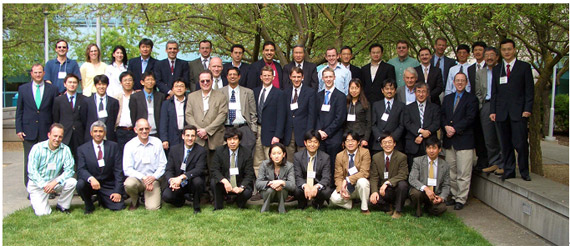|
Kohji Tokimatsu and Hiroko Suzuki, Tokyo Institute of Technology
Ross W. Boulanger, University of California, Davis

Participants at the CUEE/PEER Co-sponsored Workshop
The workshop on "Seismic performance and simulation of pile foundations in liquefied and laterally spreading ground" was held at the University of California, Davis (UC Davis), California, on March 16-18, 2005, under the co-sponsorship of the Pacific Earthquake Engineering Research (PEER) Center through the Earthquake Engineering Research Centers Program of the National Science Foundation (under contract 2312001), and the Center for Urban Earthquake Engineering (CUEE) at the Tokyo Institute of Technology, Japan, through the 21st Century COE program entitled “Evolution of Urban Earthquake Engineering” sponsored by Japanese Ministry of Education, Culture, Sports, Science, and Technology (MEXT).
UC Davis is one of the fifteen host universities in the Network for Earthquake Engineering Simulation (NEES) funded by the National Science Foundation. The Center for Geotechnical Modeling at UC Davis is equipped with one of the largest geotechnical centrifuges (9 m in radius) in the world, enabling researchers to explore various issues in the filed of geotechnical earthquake engineering such as the behavior of pile foundations in liquefied and laterally spreading ground.
The workshop objectives are to facilitate and document the synthesis of recent advances in performance and simulation of pile foundations in liquefied and laterally spreading ground, together with the common theme on the implications for design practice and the identification of areas of consensus as well as areas of continuing debate, including the following design issues.
- Fundamentals of behavior & their implications for design.
- Nonlinear analyses and their role/insights for design.
- Simplified design procedures.
A total of 47 participants from industry and academia attended the workshop, including individuals from Japan , England , Taiwan , and the US , and 34 technical presentations were given.
An important observation made by participants and discussion moderators was that relatively consistent viewpoints had emerged on several topics that had been strongly debated at past workshops, and that more complex questions of analysis and design were now moving to the forefront of our discussions.
At the present workshop, there was relatively consistent agreement on the general mechanisms of soil-pile interaction in liquefied soils, which can be attributed to the broad range of numerical and physical modeling studies that have systematically addressed the questions raised at previous meetings. The notable consequence of this and other areas of common agreement was more effective communication among participants when addressing complex issues of numerical simulation and design. In this regard, it is clear that the interactions and discussions among participants at this and previous workshops have helped speed advances in this challenging area of research.
We are confident that ongoing research will systematically address the numerous remaining issues that were identified and debated at the workshop, and that we will continue to see rapid improvements in our abilities for simulation and performance-based design of pile foundations subject to liquefaction hazards. Rapid progress requires the talents of many individuals, and for this reason it is very promising to see the numerous collaborations that have been established among different research groups in the past several years.
A special publication, Geotechnical Special Publication No. 145, has been printed recently (2006) under the sponsorship of the Earthquake Engineering and Soil Dynamics Committee of the Geo-Institute of American Society of Civil Engineers (ASCE), which contains 25 papers from the 34 technical presentations that were given at the workshop. |
